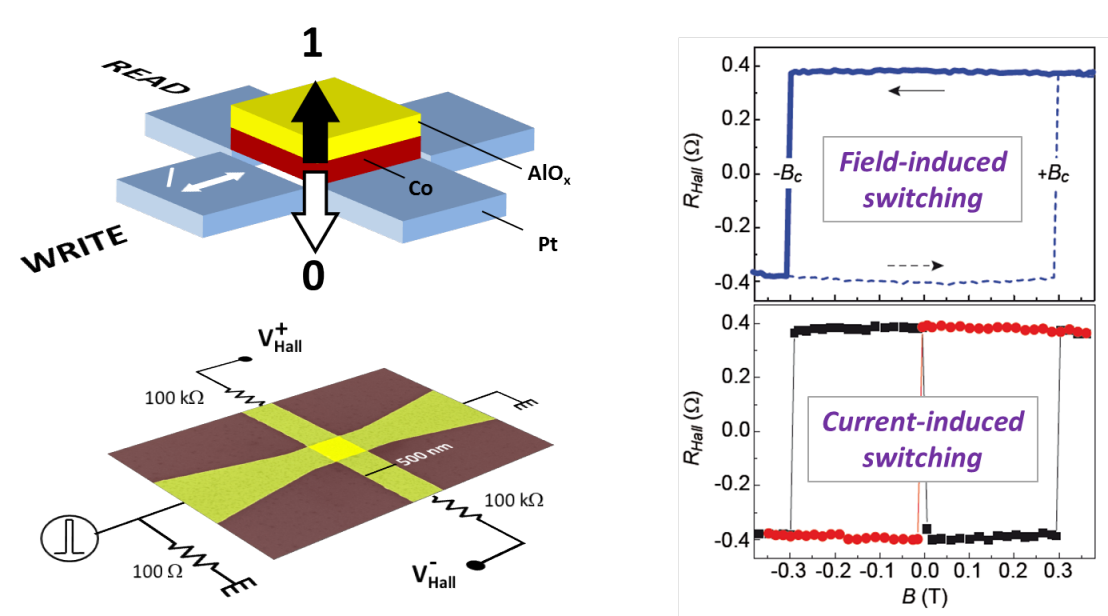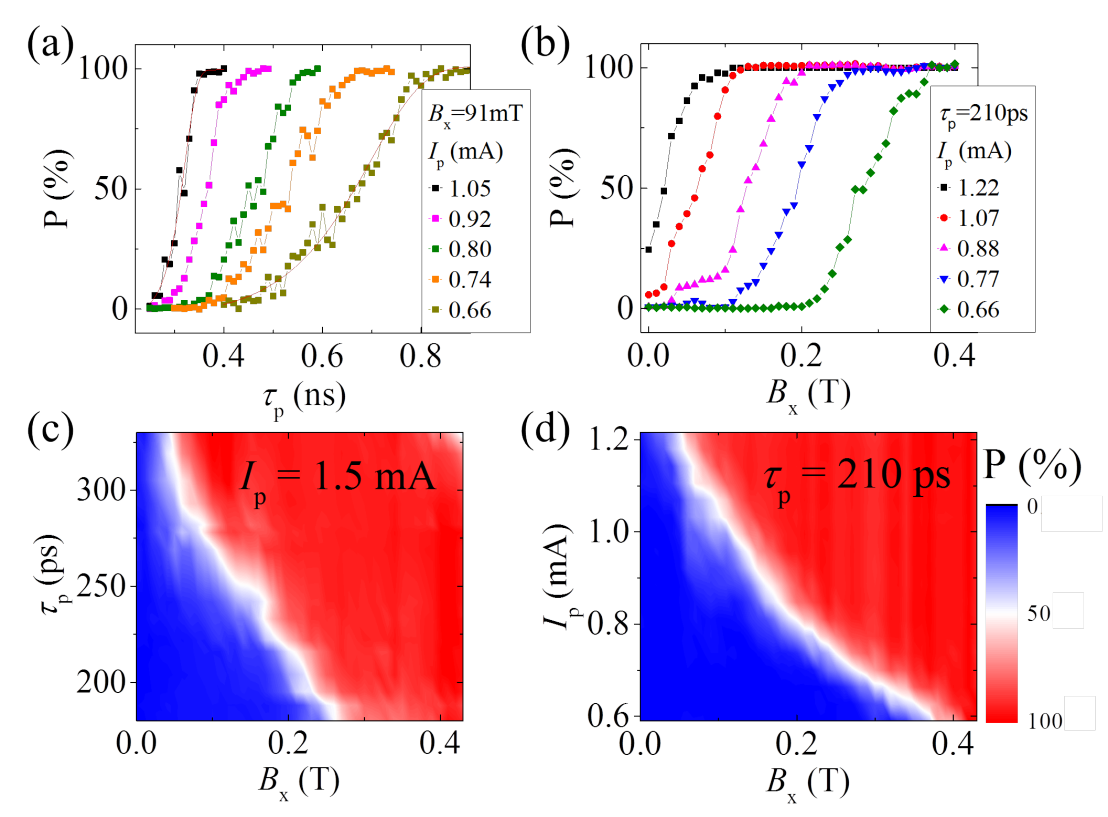Current-induced magnetization switching

Computer files that allow us to watch videos, store pictures, and edit all kinds of media formats are nothing else but streams of “0” and “1” digital data, that is, bits and bytes. Modern computing technology is based on our ability to write, store, and retrieve digital information as efficiently as possible. In a computer hard disk, this is achieved in practice by writing information on a thin magnetic layer, where magnetic domains pointing “up” represent a “1” and magnetic domains pointing down represent a “0”. The size of these magnetic domains has now reached a few tens of nanometers, allowing us to store a Terabyte of data in the space of just a few square centimeters. Miniaturization, however, has created numerous problems that physicists and engineers worldwide struggle to solve at the pace demanded by an ever-growing information technology industry. The process of writing information on tiny magnetic bits one by one, as fast as possible, and with little energy consumption, represents one of the biggest hurdles in this field.
Recently, we have discovered a new method to write magnetic data that fulfils all of these requirements. Magnetic writing is currently performed using magnetic fields produced by wires and coils, a methodology suffering severe limitations in scalability and energy efficiency. The new technique eliminates the need for cumbersome magnetic fields and provides extremely simple and reversible writing of memory elements by injecting an electric current parallel to the plane of a magnetic bit. The key to this effect lies in combining a heavy metal such as Platinum, i.e., a material with large spin-orbit coupling, with a thin ferromagnetic layer such as Cobalt. This is done by depositing one material on top of the other in controlled conditions, using either sputter deposition or molecular beam epitaxy. Due to subtle relativistic phenomena (spin Hall and Rashba effects), electrons traversing the Pt/Co bilayer acquire a spin polarization component perpendicular to the Co magnetization. Depending on the intensity of the current and the direction of the Co magnetization, the electric current creates an effective magnetic field, intrinsic to the material, that is strong enough to reverse the magnetization. We call this an effective spin-orbit field BSO, which is equivalent to a spin-orbit torque TSO = M x BSO.
Switching by spin-orbit torques works reliably at room temperature using current pulses that last less than 1 ns in magnetic bits as small as 40 x 40 square nanometers, and further miniaturization and faster switching appear within reach. There is currently much theoretical and experimental work dedicated to the understanding of this effect, in particular to the origin of the different spin-orbit torque components, their dependence on material parameters, and influence on domain wall motion. Such torques have many interesting applications for the magnetic recording industry, and in particular for the realization of magnetic random access memories, so-called MRAMs. By replacing standard RAMs, which need to be refreshed every few milliseconds, non-volatile MRAMs would allow instant power up of a computer and also save a substantial amount of energy. An additional advantage of the switching method discussed here is that current-induced magnetic writing is efficient also for “hard” magnetic layers due to the built-in spin-orbit coupling of many of these materials. This is quite practical since hard magnets can be miniaturized to nanometer dimensions without losing their magnetic properties. This would allow the information storage density to be increased without compromising the ability to write it.

We demonstrate sucsesfull deterministic magnetization reversal with current pulses ranging from 180 ps to ms in Pt/Co/AlOx dots with lateral dimensions of 90 nm. We characterize the switching probability and critical current Ic as function of pulse length, amplitude, and external field.
Selected publications
- Real-time Hall-effect detection of current-induced magnetization dynamics in ferrimagnets, G. Sala, V. Krizakova, E. Grimaldi, C.-H. Lambert, T. Devolder and P. Gambardella, Nat. Comm. 12, 656 (2021). Downloadarticle (PDF, 921 KB)vertical_align_bottom
- Field-free spin-orbit torque switching in magnetic tunnel junctions at sub-ns timescales, V. Krizakova, E. Grimaldi, G. Sala, F. Yasin, S. Couet, G. S. Kar, K. Garello, and P. Gambardella, Appl. Phys. Lett. 116, 232406 (2020). Downloadarticle (PDF, 6 MB)vertical_align_bottom
- Single-shot dynamics of spin-orbit torque and spin transfer torque switching in 3-terminal magnetic tunnel junctions, E. Grimaldi, V. Krizakova, G. Sala, F. Yasin, S. Couet, G. S. Kar, K. Garello and P Gambardella, Nat. Nanotech. 15, 111 (2020). Downloadarticle (PDF, 5.4 MB)vertical_align_bottom Downloadsupplementary information (PDF, 869 KB)vertical_align_bottom
- Perpendicular switching of a single ferromagnetic layer induced by in-plane current injection, I. M. Miron, K. Garello, G. Gaudin, P.-J. Zermatten, M. V. Costache, S. Auffret, S. Bandera, B. Rodmacq, A. Schuhl, and P. Gambardella, Nature 476, 189 (2011). Downloadarticle (PDF, 561 KB)vertical_align_bottom Downloadsupplementary information (PDF, 1.6 MB)vertical_align_bottom
- Ultrafast magnetization switching by spin-orbit torques, K. Garello, C. O. Avci, I. M. Miron, M. Baumgarnter, A. Gosh, S. Auffret, O. Boulle, G. Gaudin, P. Gambardella, Appl. Phys. Lett. 105, 212402 (2014). Downloadarticle (PDF, 410 KB)vertical_align_bottom
- Spin-orbit torque driven chiral magnetization reversal in ultrathin nanostructures, N. Mikuszeit, O. Boulle, I. M. Miron, K. Garello, P. Gambardella, G. Gaudin, and L. D. Buda-Prejbeanu, Phys. Rev. B 92, 144424 (2015). Downloadarticle (PDF, 708 KB)vertical_align_bottom
- Ultra-Fast and High-Reliability SOT-MRAM: from Cache Replacement to Normally-off Computing, G. Prenat, K. Jabeur, P. Vanhauwaert, G. Di Pendina, F. Oboril, R. Bishnoi, M. Ebrahimi, N. Lamard, O. Boulle, M. Miron, K. Garello, J. Langer, B. Ocker, M.-C. Cyrille, P. Gambardella, M. Tahoori and G. Gaudin, IEEE Transactions on Multi-Scale Computing 2, 149 (2016). Downloadarticle (PDF, 1.4 MB)vertical_align_bottom
- Antiferromagnetic CuMnAs multi-level memory cell with microelectronic compatibility, K. Olejnik, V. Schuler, X. Marti V. Novak, Z. Kaspar, P. Wadley, R. P. Campion, K. W. Edmonds, B. L. Gallagher, J. Garces, M. Baumgartner, P. Gambardella and T. Jungwirth, Nat. Comm. 8, 15434 (2017). Downloadarticle (PDF, 882 KB)vertical_align_bottom
- Fast switching and signature of efficient domain wall motion driven by spin-orbit torques in a perpendicular anisotropy magnetic insulator/Pt bilayer, Can Onur Avci, Ethan Rosenberg, Manuel Baumgartner, Lukáš Beran, Andy Quindeau, Pietro Gambardella, Caroline A. Ross, and Geoffrey S. D. Beach, Appl. Phys. Lett. 111, 072406 (2017). Downloadarticle (PDF, 944 KB)vertical_align_bottom
- Time- and spatially-resolved magnetization dynamics driven by spin-orbit torques, M. Baumgartner, K. Garello, J. Mendil, C. O. Avci, E. Grimaldi, C. Murer, J. Feng, M. Gabureac, C. Stamm, Y. Acremann, S. Finizio, S. Wintz, J. Raabe and P. Gambardella, Nat. Nanotech., 12, 980–986 (2017). Downloadarticle (PDF, 1.9 MB)vertical_align_bottom
- Current-induced spin-orbit torques in ferromagnetic and antiferromagnetic systems, A. Manchon, J. Železný, I.M. Miron, T. Jungwirth, J. Sinova, A. Thiaville, K. Garello, and P. Gambardella, Rev. Mod. Phys. 91, 035004 (2019). Downloadarticle (PDF, 12.4 MB)vertical_align_bottom
Patents
- Current-driven magnetic domain wall logic, Z. Luo, A. Hrabec, T. P. Dao, L.J. Heyderman, P. Gambardella, European Patent application EP20161352.8 (06.03.2020).
- Magnetic memory element, G. Gaudin, I.M. Miron, P. Gambardella, A. Schuhl, ICN, CNRS, and ICREA, US Patent application 12/899,072 (06.10.2010). WO 2012/014131 (02.12.2012) external pageregistercall_made
- Writable magnetic element, G. Gaudin, I.M. Miron, P. Gambardella, A. Schuhl, ICN, CNRS, and ICREA, US Patent application 12/899,091 (06.10.2010). WO 2012/014132 (02.12.2012) external pageregistercall_made
- Writable magnetic element, G. Gaudin, I.M. Miron, P. Gambardella, A. Schuhl, ICN, CNRS, and ICREA, US Patent application 12/959,980 (03.12.2010). WO 2012/056348 (03.05.2012). external pageregistercall_made
